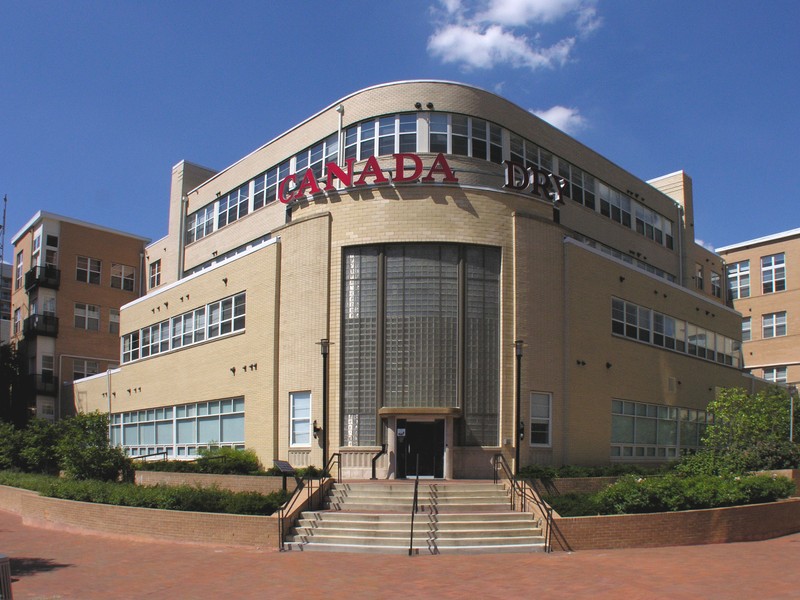Canada Dry Bottling Plant (1946-1995)
Introduction
Text-to-speech Audio
Images
Canada Dry Building by Allen C. Browne on HMDB.org (reproduced under Fair Use)

Backstory and Context
Text-to-speech Audio
Canada Dry began operations in the late nineteenth century and opened its first plant int he U.S. in 1921 in Manhattan. William Monroe Cory designed a series of plants for Canada Dry in the mid 1940s, adapting his main design for local constructions. The Silver Spring opened in 1946 along a developing industrial boulevard in downtown Silver Spring, and it adjoined the B&O Railroad tracks to facilitate shipping. Built in the Streamline Moderne style, the plant has a steel frame construction with concrete decks and exposed wood planking. Multiple glazing techniques were used throughout the administrative structure, notably in the large glass blocks making up the lobby's rotunda window. The company repeated Cory's design as a marketing tool; modern design, the visibility of beverage production by the public, and a focus on sanitary conditions all became elements of the brand.
Canada Dry operated here from 1946 to 1995, after which it was used as warehouse space. Eventually AT&T purchased the plant to use as a switching station in 1999, but before long economic downturn led to the building being sold again. JGB Properties bought the building for adaptive reuse as residential property. The lobby and Canada Dry "crown" remains thanks largely to the efforts of the Silver Spring Historical Society whose members spearheaded an effort to preserve parts of the structure given their architectural significance. In the administrative building, the landmark red lit "Canada Dry" sign, the ginger-colored glass tiles, terrazzo floors, and the lobby rotunda were all important features of the structure. The Montgomery County Historic Preservation Commission recommended the plant's designation as a twentieth century industrial resource. The county Planning Board approved preservation only for the central portion of the structure. Parts of the structure outside this portion were demolished in the early 2000s. In 2003-2004, the American Historic Engineering Record documented both structures, and these records reside in the Library of Congress.
Cite This Entry
Duplisea, Genna and Clio Admin. "Canada Dry Bottling Plant (1946-1995) ." Clio: Your Guide to History. August 23, 2020. Accessed March 17, 2025. https://theclio.com/entry/112970
Sources
Browne, Allen C. Canada Dry Building, Historical Marker Database. June 16th 2016. Accessed August 20th 2020. https://www.hmdb.org/m.asp?m=75058.
Historic American Engineering Record. Canada Dry Bottling Plant, Library of Congress. 2003. Accessed August 20th 2020. http://www.loc.gov/pictures/item/md1587.
Silver Spring Historical Society. Save the Canada Dry Building! Accessed August 20th 2020. http://silverspringhistory.homestead.com/canada.html.
Ziek, Robin D.. Canada Dry Bottling Plant, Historic American Engineering Record. 2004. Accessed August 21st 2020. http://cdn.loc.gov/master/pnp/habshaer/md/md1500/md1587/data/md1587data.pdf.
https://www.hmdb.org/PhotoFullSize.asp?PhotoID=278035

